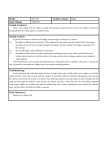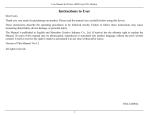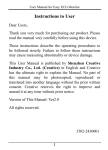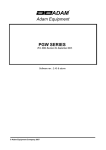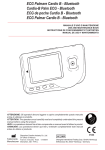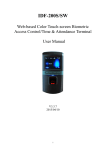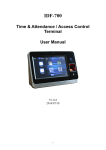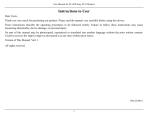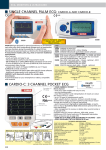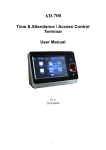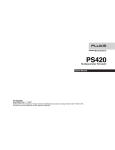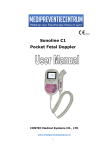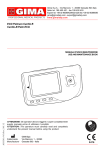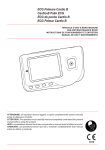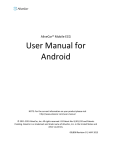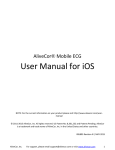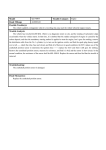Download 用 户 须 知 - CkHealth.de
Transcript
User Manual for Easy ECG Monitor Instructions to User Dear Users, Thank you very much for purchasing our product. Please read the manual very carefully before using this device. These instructions describe the operating procedures to be followed strictly. Failure to follow these instructions may cause measuring abnormality, device damage, or personal injury. The Manual is published in English and we have the ultimate right to explain the Manual. No part of this manual may be photocopied, reproduced or translated into another language without the prior written consent. We reserve the right to improve and amend it at any time without prior notice. Version of This Manual: Ver1.0 June 7, 2010 All rights reserved. 3502I User Manual for Easy ECG Monitor Announcement Information furnished by the manufacturer is believed to be accurate and reliable. However, no responsibility is assumed by Creative for its use, or any infringements of patents or other rights of third parties that may result from its use. Declaration of Conformity: Creative hereby declares that this device complies with the following standards: IEC 60601-1 IEC 60601-1-2 and follows the provisions of the Council Directive MDD 93/42/EEC. II User Manual for Easy ECG Monitor WARNING 1. Check the device to make sure that there is no visible damage that may affect user’s safety and measurement performance. Stop using the unit, when there is obvious damage. 2. Do NOT make diagnosis oneself by the measurement and measurement results, always consult the doctor if abnormal information is presented frequently. 3. It is NOT designed or intended for medical diagnosis. 4. Do NOT use the device in the bathroom or moist circumstance. 5. Do NOT use if you carry a cardiac pacemaker. 6. Do NOT operate in the environment where strong electro-magnetic interference exists. 7. Necessary service must be performed by qualified service engineers ONLY. 8. Clinical ECG examination is suggested for normal examination of your heart condition. III User Manual for Easy ECG Monitor 9. Connect/Disconnect data cable to the monitor gently and carefully, do NOT wring or shake the data cable plug with force to insert into or unplug from data interface port, or the data interface port may be damaged. 10. Dispose of the expired device and its accessories according to applicable local regulations. Caution: U.S. federal law restricts this device to sale by or on the order of a physician. IV User Manual for Easy ECG Monitor Table of Contents 1 OVERVIEW ....................................................................................................... 1 1.1 APPEARANCE ................................................................................................ 1 1.2 NAME AND MODEL ....................................................................................... 3 1.3 STRUCTURE .................................................................................................. 3 1.4 FEATURES ..................................................................................................... 3 1.5 APPLICATION SCOPE .................................................................................... 4 1.6 OPERATING ENVIRONMENT ......................................................................... 4 2 INSTALLATION ................................................................................................ 5 2.1 INSTALLATION OF BATTERIES ...................................................................... 5 2.2 INSERT/REMOVE SD CARD .......................................................................... 6 3 OPERATION ...................................................................................................... 7 3.1 START TO MEASURE ECG ............................................................................ 7 3.2 ECG MEASUREMENT ................................................................................. 10 3.3 WAVE REVIEW ............................................................................................ 19 3.4 DATA MANAGEMENT .................................................................................. 28 V User Manual for Easy ECG Monitor 3.5 SYSTEM SETTING ....................................................................................... 34 3.6 HELP ........................................................................................................... 41 4 TECHNICAL SPECIFICATIONS .................................................................. 42 4.1 ECG MEASUREMENT ................................................................................. 42 4.2 POWER........................................................................................................ 43 4.3 CLASSIFICATION......................................................................................... 43 4.4 DISPLAY ...................................................................................................... 44 4.5 DATA MEMORY ........................................................................................... 44 4.6 OVERALL DIMENSION AND WEIGHT .......................................................... 44 5 ACCESSORIES ................................................................................................ 45 6 MAINTENANCE AND SERVICE .................................................................. 46 7 TROUBLESHOOTING ................................................................................... 48 8 ERROR PROMPTING AND ELIMINATION .............................................. 50 9 KEY OF SYMBOLS......................................................................................... 53 APPENDIX .......................................................................................................... 54 GENERAL KNOWLEDGE OF ECG ..................................................................... 54 VI User Manual for Easy ECG Monitor 1 Overview 1.1 Appearance 1. Power: Long time press (about 2 seconds) makes the device power on or off. 2. Metal Electrode I, II 1 User Manual for Easy ECG Monitor 3. Measurement: shortcut button for measuring, press this button to start measuring. 4. ▇ OK: confirm selection or modification. 5. Navigation key: /Up/left/increase: move the cursor upwards/to the left, or adjust parameter values. /Down/right/decrease: move the cursor downwards/to the right, or adjust parameter values. 6. Return: back to upper level of menu. 7. Display screen: display ECG waveforms and data. 8. Metal Electrode III 9. SD CARD: SD Card port. 10. Lead wire socket: for connecting to lead wire. 2 User Manual for Easy ECG Monitor 11. Data interface port: for connecting to data cable (optional). 1.2 Name and Model PC-80B Easy ECG Monitor 1.3 Structure PC-80B Easy ECG Monitor consists of main board, panels and electrodes. 1.4 Features 1. Small in size and light in weight to carry. 2. One-key measurement, easy to operate. 3. ECG waveform and interpretation of results are displayed clearly on colour LCD screen. 4. Seventeen types measurement result can be presented. 5. Up to 300 records can be stored in built-in memory. 6. Support SD Card to extend memory capacity. 7. Data records can be reviewed, copied, deleted, and uploaded to PC as well. 3 User Manual for Easy ECG Monitor 8. Power saving technique with automatic shutting-off function. 9. Two AAA batteries can be used for more than 1000 times measurement. 1.5 Application Scope PC-80B Easy ECG Monitor is intended for self-monitoring and storing patient’s ECG waveform and heart rate. The unit is not the monitor used in clinical institution or hospital, but is used for spot-check purpose ONLY. It can not be used to substitute the normal ECG examination or real time monitoring. The measurement results are a useful reference for doctor, but do not make direct diagnostic or analytical decision based on the information provided by this unit. 1.6 Operating Environment Operating temperature 5~40℃ Operating humidity ≤80% Atmospheric pressure 86~106kPa 4 User Manual for Easy ECG Monitor 2 Installation 2.1 Installation of Batteries 1. Open the battery cover (see the Figure 2-1). 2. Insert two AAA size batteries directly. 3. Close the battery cover. Do NOT insert batteries with their polarities reversed. Dispose of the used batteries according to applicable local regulations. Figure 2-1 Note: Protecting films are attached to the electrodes of device, so please remove the protecting films before measurement. 5 User Manual for Easy ECG Monitor 2.2 Insert/Remove SD Card Please use the SD card with the memory not more than 8GB, or it may not compatible with the device. The following brand and capacity of the SD card are tested to work normally with this device: SanDisk (≤8GB), Kingston (≤8GB). Insert SD card: 1. Open the rubber cover of SD card. 2. Insert the SD card into the SD card slot, make sure that the golden contactors face downward (see the Figure 2-2). 3.Push the SD card to make it locked, and then close the rubber cover. Remove SD card: 1. Open the rubber cover of SD card. Figure 2-2 Insert SD Card 2. Push the SD card to make it pop-up. Please switch off the monitor 3. Remove the SD card , and then close when inserting or removing SD card. the rubber cover. 6 User Manual for Easy ECG Monitor 3 Operation 3.1 Start to measure ECG Press the Power button (lasting for 2 seconds) to turn on the unit. The unit starts to initialize, and displays the following pictures Figure 3-1A and Figure 3-1B. Figure 3-1A Figure 3-1B After boot-strap, the unit enters into menu screen, as shown in Figure 3-2. 7 User Manual for Easy ECG Monitor Note: During initialization, press “ Return” button to enter into main menu screen, as shown in Figure 3-2. If press “ Measurement”, it will enter into measuring screen, as shown in Figure 3-4. There are 6 tool buttons, press navigation key to shift cursor and press “ OK” to confirm. Each functional button will be defined as follows: Measure: detect ECG waveform and HR value, and analyze whether the ECG waveform is normal. Review: review the ECG records saved in this device or in SD card (including ECG waveform and measurement result). Figure 3-2 8 User Manual for Easy ECG Monitor Memory: delete the ECG records saved in this unit or in SD card; copy ECG records to SD card or upload the ECG records to PC. Setting: set system date, time, language, mode, brightness and contrast etc. parameters. Help: provide with measuring methods etc. information. 中文: for changing the current system language to Chinese(中文). Note: “ ” is SD card symbol, there is no SD card symbol if SD card is not inserted into the device. 9 User Manual for Easy ECG Monitor 3.2 ECG Measurement 3.2.1 ECG Measuring Method 1 Chest Measurement In order to obtain ideal ECG waveform, chest measurement is suggested firstly. Hold the device with the right hand. Make sure that the palm and fingers touch the metal electrode I and II reliably. Place the electrode III on bare skin about 5cm away below the left nipple. The ECG signal detected by Chest Measurement is similar to Lead V ECG signal. Improper operating method: Figure 3-3A Chest Measurement A. The contact place of electrode III deviates from left chest. B. The holding gesture is incorrect. C. The electrode can not contact bare skin completely. (For example place the electrode on clothing.) 10 User Manual for Easy ECG Monitor 2 Leg Measurement If it is not convenient to use chest measurement, the leg measurement will be recommended. When measuring, hold the device with the right hand. Make sure that the palm and fingers touch the metal electrode I and II reliably. Place the electrode III on the skin 10cm away above the left foot ankle. The ECG signal detected by Leg Measurement is equivalent to Lead II ECG signal. Figure 3-3B Leg Measurement Improper operating method: A. Wrong holding gesture. B. The electrode III can not contact bare skin completely. (For example, place the electrode III on the sleeve of trousers or socks.) 11 User Manual for Easy ECG Monitor 3 Palm Measurement Hold the device with right hand. Make sure that the palm and fingers touch the metal electrode I and II reliably. Press the electrode III close against the center of the left palm. The ECG signal detected by Palm Measurement is equivalent to Lead I ECG signal. 3-3C Palm Measurement Improper operating method: A. Waving your both hands at will. B. Both hands loose contact with electrodes during measurement. C. Not palm contacts the electrode. 12 User Manual for Easy ECG Monitor 4 Lead Wire Measurement For the sake of high quality ECG, lead wire measurement can be used. Connect the lead and the device effectively by lead wire socket. Place the electrodes and connect the lead wires as the figure below to obtain the Lead II ECG signal; if you want to measure Lead I and Lead III ECG signal, according to the following table to connect the lead wires to the electrodes. Figure 3-3D Lead Wire Measurement Improper operating method: A. Wrong in connecting lead port. B. Place the electrode in the wrong part of your body. 13 User Manual for Easy ECG Monitor Electrode Lead Name Electrode Location The intersection between the centerline of the right clavicle and Rib 2. The intersection between the centerline of the left clavicle and Rib 2. Between the left edge of the breast bone and Rib 5 Lead Lead Lead I II RA RA LA LL LA RA LA LL LL ECG Leads Configuration and Electrodes Location Table 14 III User Manual for Easy ECG Monitor 3.2.2 Measuring Procedure 1. Press “ Measure” to enter into ECG measuring screen, as shown in Figure 3-4. The first 6 seconds is preparing phase, during this period the unit will judge whether the placed position is befitting. Please adjust your holding position if the detected waveform is not smooth. Figure 3-4 Measuring Screen On-screen display: 1. “16: 14: 32”: current time. 15 User Manual for Easy ECG Monitor 2. “X1”: ECG waveform amplitude scale. “X1/2”: half size of the nominal scale; “X1”: nominal scale; “X2”: twice the size of the nominal scale; “X3”: three times the size of the nominal scale. 3. “ 4. “ ”: indicates that ECG filter mode is “Enhanced”; Refer to section 3.5.6 for filter setting. 5. “ ”: Status of battery power 6. “ ”: ECG waveform 7. “ ”: Ruler for 1mV amplitude 8. “ ”: heart beat indicator. It flashes while heart beats. ”: Status bar of measurement progress. 2. When finishing measurement, it enters into the result display phase, as shown in Figure 3-5. 16 User Manual for Easy ECG Monitor Figure 3-5 Measurement Result Screen Figure 3-6 Data Saving “ Return”: return to main menu screen directly and the current measurement result and measuring value won’t be saved. “ Save”: save the current measurement result and measuring value. 3. The current measurement data will be saved in this device automatically without any operation in 6 seconds, as shown in Figure 3-6. Notes: 1)This device provides with 17 types measurement result, refer to Table 3-1(Section 3.3.3) for details. 17 User Manual for Easy ECG Monitor 2)During measurement, if the measured part and metal electrodes loose contact, the device will prompt “Contact?”, as shown in Figure 3-7. Figure 3-7 Figure 3-8 3)Up to 300 records can be saved in this device. When the number of records is over 300 pieces, the device will prompt that “Memory full! Overwrite record?”, as shown in Figure 3-8. Select “YES”, then press “ OK” button to overwrite the earliest record; if the current record needn’t to be saved, press “ Return” button to exit. 18 User Manual for Easy ECG Monitor 3.3 Wave Review 3.3.1 Operation Description 1. Select “Review” on main menu screen, then press OK key, the display screen is as shown in Figure 3-9. Device: review the records saved in device. SD Card: review the records saved in SD Card, if the SD Card has not been inserted into the device, the SD Card icon is gray (unselected marker). Figure 3-9 2. Select “Device” or “SD Card” with Navigation Key, then press “ OK” button, the device will enter into record list screen, as shown in Figure 3-10: 19 User Manual for Easy ECG Monitor Note: “ ”: means the measured result of this record isn’t found irregularity. “ ”: means the measured result of this record is abnormal. “ ”: means wave interference or lead off during measuring. “ ”: means the enhanced mode is used during measuring. Figure 3-10 Record List 3. Choose a piece of record in record list, then press “ OK” button to review this ECG record, the display screen is as shown in Figure 3-11. To stop auto replay, just press the Navigation key “/” or “/”. After that you can press the Navigation key “/” or “/” again to view the waveforms manually. 20 User Manual for Easy ECG Monitor On-screen display: Figure 3-11 ECG Data Review Screen 1. “16: 14: 32”: ECG waveform measuring time. 2. “X1”: ECG waveform amplitude scale. “X1/2”: half size of the nominal scale; “X1”: nominal scale; “X2”: twice the size of the nominal scale; “X3”: three times the size of the nominal scale. 21 User Manual for Easy ECG Monitor 3. “HR=66”: heart rate value is 66bpm. 4. “ ”: indicates that ECG filter mode is “Enhanced”; Refer to section 3.5.6 for filter setting. 5. “ ”: Status of battery power 6. “ ”: measured ECG waveform 7. “ ”: Ruler for 1mV amplitude. 8. “ 9. “ ”: ECG waveform miniature. ”: ECG waveform selecting box. Note: ① the selected waveform in selecting box is displayed on the current screen. ② ECG waveform miniature in selecting box is the ECG waveform measured in 30 seconds. 4. Press “ OK” button again, the measurement result of this record will be reviewed on the screen, as shown in Figure 3-12. 22 User Manual for Easy ECG Monitor Figure 3-12 (1) “ Return”: press “ Figure 3-13 Return” button to return to record list screen. (2) “ Delete”: press “ OK” button to delete the selected current record, at this time it prompts that “Sure to delete?”, as shown in Figure 3-13. 5. Select “YES”, then press “ OK” button to perform deletion and return to record list screen. Press “ Return” button directly, this record will not be deleted and the screen will return to record list screen. 23 User Manual for Easy ECG Monitor 3.3.2 Measurement Result Description When device detects lead off or suspected arrhythmia ECG waveform, “Poor signal, measure again (Figure 3-14)”, “Suspected a little slow beat (Figure 3-15)” etc. 17 types ECG measurement results can be obtained. Refer to Table 3-1 for details. ⑴. Poor signal ⑵.A little slow beat Figure 3-14 Figure 3-15 3.3.3 Measurement Result Table 24 User Manual for Easy ECG Monitor No. 1 ECG Measurement Descriptions No irregularity found Result 2 Suspected a little fast beat 3 Suspected fast beat 4 Suspected short run of fast beat 5 Suspected a little slow beat 25 Waveform User Manual for Easy ECG Monitor 6 Suspected slow beat 7 Suspected occasional short beat interval 8 Suspected irregular beat interval 9 Suspected fast beat with short beat interval 10 Suspected slow beat with short beat interval 11 Suspected slow beat with irregular beat interval 26 User Manual for Easy ECG Monitor 12 Waveform baseline wander 13 Suspected fast beat with baseline wander 14 Suspected slow beat with baseline wander 15 Suspected occasional short beat interval with baseline wander 16 Suspected irregular beat interval with baseline wander 17 Poor Signal, measure again Table 3-1 27 User Manual for Easy ECG Monitor 3.4 Data Management Select “Data Management” on main menu screen, then press “ OK” button to enter into data management screen, as shown in Figure 3-16. Figure 3-16 Data Management Screen 28 User Manual for Easy ECG Monitor 3.4.1 Data Deletion 1. On data management screen, select “Delete all” with Navigation Key, then press “ OK” button, next choose the data saved in “Device” or “SD Card”, as shown in Figure 3-17. Figure 3-17 Figure 3-18 2. After selection, press “ OK” button to delete data. Prior to deletion, a dialogue box “Sure to delete all?” will present on the screen, as shown in Figure 3-18. 29 User Manual for Easy ECG Monitor If choose “YES” and press “ OK” button, all the records will be deleted, as shown in Figure 3-19. Figure 3-19 Records Deleting Note: On data management screen, you can delete all the data in the device or in the SD Card; if you want to delete a piece of record, please delete the record on wave review screen. 30 User Manual for Easy ECG Monitor 3.4.2 Upload Data On data management screen, select “Upload data” to enter into upload data screen, as shown in figure 3-20. Figure 3-20 Upload Data Screen On this screen, you can transmit data to PC for data management, review and interpretation through PC-80B data cable (optional). Press “ Return” button to return. 31 User Manual for Easy ECG Monitor 3.4.3 Copy Data On data management screen, select “Copy data” to enter into copy data screen, as shown in figure 3-21. Suggestion: Before copying data to SD card, please back up the original data in SD card and format the SD card. Figure 3-21 Figure 3-22 Choose “YES” and press “ OK” button, the data in the device will be copied to SD Card (shown as Figure 3-22) one record by one record. If press “ Return” button 32 User Manual for Easy ECG Monitor directly, the screen will return to data management screen. Note: 1. On data management screen, if no SD Card in the device, the option “Copy data” is gray. 2. Ensure that there is enough battery power for performing data deletion, copying data and uploading data, or low battery will make the device stop coping. 33 User Manual for Easy ECG Monitor 3.5 System Setting On the main menu screen, select “Setting” with Navigation Key, then press “ OK” button to enter into system setting screen, as shown in Figure 3-23 A and Figure 3-23B. Figure 3-23A Figure 3-23B 34 User Manual for Easy ECG Monitor 3.5.1 Time/Date Setting 1.On system setting screen, select “Time/date” with Navigation Key, then press “ OK” button to enter into time and date setting screen (date format: dd/mm/yyyy), as shown in Figure 3-24. 2. Use Navigation Key to adjust the value, and then press “ OK” button to shift black cursor and adjust another value. 3. When finish the settings, press “ OK” button to save setting and return to the upper level menu screen. Figure 3-24 Time/date Setting 35 User Manual for Easy ECG Monitor 3.5.2 Language Setting 1. On system setting screen, select “Language” to enter into language information screen, as shown in Figure 3-25. There are two kinds of different softwares. One is with two system languages: “简体 中文(Chinese)” and “English”, the other is only with a system language: “English”. Figure 3-25 Language Setting 36 User Manual for Easy ECG Monitor 3.5.3 Brightness Setting 1. On system setting screen, select “Brightness” to enter into brightness setting screen, as shown in Figure 3-26. 2. Adjust brightness with Navigation Key; 1~7 level adjustable; 3. Press “ OK” button to save setting and return to the upper level menu screen. Figure 3-26 Brightness Setting 37 User Manual for Easy ECG Monitor 3.5.4 Beeper Setting 1. On system setting screen, select “Beeper” to enter into beeper setting screen, as shown in Figure 3-27. 2. Choose “ON” or “OFF” with Navigation Key to turn on the beeper or turn off the beeper; the default setting is “ON”. 3. Press “ OK” button to save setting and return to the upper level menu screen. Figure 3-27 Beeper Setting 38 User Manual for Easy ECG Monitor 3.5.5 Measure Mode Setting 1. On system setting screen, select “Measure mode” to enter into measure mode setting screen, as shown in Figure 3-28. 2. Choose “Normal” mode or “Enhanced” mode with Navigation Key. The default setting is “Normal” mode. Normal mode: can filter the interference signal in ECG waveform. Enhanced mode: can better reflect the fidelity of ECG waveform. 3. Press “ Return” button to save the setting and back to upper level menu screen. 39 Figure 3-28 Measure Mode Setting User Manual for Easy ECG Monitor 3.5.6 Resume Default 1. On system setting screen, select “Default setting” to enter into default setting screen, as shown in Figure 3-29. 2. Choose “YES” or “NO” with Navigation Key. If the choice is “YES”, then press “ OK” button, all the parameter settings will resume default settings. 3. Press “ level menu. Return” button to back to upper Figure 3-29 Default Setting 40 User Manual for Easy ECG Monitor 3.5.7 Version Info On system setting screen, select “Version” to enter into version information screen, as shown in Figure 3-30. “V09-09-21” is version number. Figure 3-30 Version Information 3.6 Help On main menu screen, select “Help”, then press “ OK” button to enter into help info screen. It provides with different kinds of illustrations for ECG measuring methods. Refer to Section 3.2.1 for ECG measuring methods in details. 41 User Manual for Easy ECG Monitor 4 Technical Specifications 4.1 ECG Measurement 1. The number of channels: Single (differential input). 2. Electrodes: 3 embedded metal electrodes or using 3 adhesive ECG electrodes by connection to the lead wire. 3. Measurement modes: the detecting ECG signal can be detected by the following lead selection: Lead I (between right hand and left hand); Chest Lead (between right hand and chest); Lead II (between right hand and left leg). 4. ECG bandwidth: 0.5Hz~40Hz 5. Internal noise level: ≤30μVp-p 6. Heart Rate measuring range: 30bpm~240bpm 7. Heart Rate measuring accuracy: ±2bpm or ±2% whichever is greater 42 User Manual for Easy ECG Monitor 8. Display scale: 5.0mm/mV±10% 9. Common-mode rejection ratio (CMRR): ≥60dB 10. Waveform sweeping speed: 20mm/s±10% 11. Input loop current: ≤1μA 12. Input impedance: ≥5 MΩ 4.2 Power Power: 2×AAA alkaline batteries Supply voltage range: 2.7~3.3VDC Max average working current: ≤50mA Auto power-off: 35s±5s (without operation) Low battery indication: 2.5VDC±0.2VDC 4.3 Classification 1. The type of protection against electric shock: Internally powered equipment 2. The degree of protection against electric shock: Type B applied part 43 User Manual for Easy ECG Monitor 3. The degree of protection against harmful ingress of liquid: Ordinary equipment without protection against ingress of liquid. 4. Electro-magnetic Compatibility: Group I, Class B 4.4 Display 1. LCD type: colour LCD 2. Display area: 57.6mm × 40mm 4.5 Data Memory 1. 300 records can be saved in the built-in memory; SD Card is supported for extended memory. (Optional) 2. Stored data records can be uploaded to the computer by data cable provided by the manufacturer. (Optional) 4.6 Overall Dimension and Weight Dimension: (L) 125× (W) 70 × (H) 21.5 mm Weight: 106g (not including batteries) 44 User Manual for Easy ECG Monitor 5 Accessories A hanging cord Two batteries (AAA) A wallet A User Manual A data cable (optional) An ECG lead wire (optional) Note: The accessories are subject to change. Detailed items and quantity see the Packing List. 45 User Manual for Easy ECG Monitor 6 Maintenance and Service 1. Please change the batteries, when appears low-voltage icon. 2. It is recommended to wipe the metal electrode with medical alcohol, when the measuring signal is too weak. 3. Please wipe the surface of the unit with clean cloth or let it dry in air. 4. Please take out the batteries if the unit will not be used for a long time. 5. Storage and Transportation Ambient temperature: -20 to 60ºC Relative humidity: 10~ 95% Atmospheric pressure: 50~107.4KPa This device should be transported by land (vehicle or railway) or air in accordance with the contractual terms. Do not hit or drop it with force and protect it from sunlight and rain. 46 User Manual for Easy ECG Monitor Notes Keep it away from corrosive substances, explosive substances, high/low temperature and moisture. If the device gets wet or has water steam, please stop operating it. When it is taken from cold environment to warm and humid environment, please DO NOT use it immediately. DO NOT operate the button on front panel with sharp materials. DO NOT immerge the device into liquid. Do NOT spray any liquid on it directly. The life of this unit is 5 years. In order to ensure its long service life, please pay attention to the use of maintenance. Please use the SD card with the memory not more than 8GB, or it may not compatible with the device. The following brand and capacity of the SD card are tested to work normally with this device: SanDisk (≤8GB) Kingston (≤8GB) 47 User Manual for Easy ECG Monitor 7 Troubleshooting Trouble The device can not turn on. Possible Reason 1. The batteries are drained or almost drained. 2. The batteries are not inserted properly. 3. The device is broken out. Solution 1. Change batteries. 2. Reinstall batteries. 3. Please contact the local service center. Trouble The device is failure in measuring heart rate. 48 User Manual for Easy ECG Monitor Possible Reason 1. Electrode and body does not contact well. 2. Moved when measuring. 3. Electromagnetic interference. 4. Weak signal. Solution 1. Place the electrode correctly. 2. When measuring, please keep quiet and avoid moving. 3. Keep away from interference source. 4. Change a place (chest) to measure. Trouble ECG waveform excursion, strong irrelevant waveform or the ECG waveform displays on the screen, but the prompt info is “Contact?”; Possible Reason 1. Skin is dry or oily. 2. Electrode and body does not contact tightly. 3. Muscle strain. Solution 1. Clean skin with soap and water and eliminate skin crumb and grease to make the skin wet and greaseless. 2. Press the electrode with a certain force. 3. Keep hand relax while measuring. 49 User Manual for Easy ECG Monitor Trouble After inserting the SD card, the device is off automatically. Possible Reason Your SD card is not compatible with the device. Solution Keep the SD card in the device and restart the device for normal use. 8 Error Prompting and Elimination Flash in device Error Memory error Memory full Reason Flash in this device writing operation error The memory of flash is full 50 Solution Try again, if problem still exits please change flash. Backup data to SD card then clear the memory in flash or recover data directly User Manual for Easy ECG Monitor SD Card Error Unknown card Reason Only support standard SD cards. The memory of SD card is more than 8GB. SD is SD Card is unformatted unformatted to FAT format file system SD is SD Card is write-protect write-protected. SD write SD Card writing error operation error Memory full The memory of SD Card is full. Solution Use standard SD card(such as SanDisk) The memory of SD card should be no more than 8GB. Please format the SD Card to FAT format file system on your PC. Please open the SD Card Write-protect lock. Reinsert SD Card and try again, if error still exits please format the SD Card and try again. Please delete the data in SD Card 51 User Manual for Easy ECG Monitor Error SD Card error Reason Device fault or SD Card fault. Solution Reinsert SD Card and try again, if error still exits: 1. please format the SD Card and try again. 2. Change a SD Card and try again. 3. The device may be damaged. 52 User Manual for Easy ECG Monitor 9 Key of Symbols Symbol Description Symbol Heart Rate (Unit: beats per minutes) Measure mode: enhanced inminute) Return button Battery indicator SD card symbol ▇ Confirmation button / / Navigation key Power button Type B Data Interface Port Lead wire socket SN ”, “ Serial number Separate collection for this device. Warning ─ See User Manual Note: The symbols “ Description ”, “ ”, “ ” are displayed on the screen, the others are marked on the device panel. 53 User Manual for Easy ECG Monitor Appendix General Knowledge of ECG ⅠNormal sinus rhythm: In sinus conditions, SA node paces the heart with the regularly rate and the normal rhythm. The heart rate is in the range of 60 to 100 times per minute and the rhythm is regular. P wave is normal and each one is followed by a QRS wave. P-R interval: 0.12~0.20s; QRS wave: 0.06~0.10s; No ectopic ECG activity. Figure 1 Normal ECG Waveform Symptom: Sinus rhythm, heart rate: 60~100bpm Indication: Normal Ⅱ Several abnormal ECG waveforms 1) Tachycardia: The heartbeat becomes faster. Tachycardia is determined by the rhythm of the heart, the average rhythm beats faster than 100 times a minute is 54 User Manual for Easy ECG Monitor considered as Tachycardia. The result description “Suspected fast beat” in this device may be doubted as Tachycardia. Symptom: heart rate>100bpm Indication: It may occur with the normal people who have these physiology conditions: rage, fatigue, smoking, drinking too much wine, excessive coffee and strong tea, etc. Figure 2 Tachycardia Waveform Pathology: anemia, Hyperthyroidism, blood hypoxia, myocarditis, hypokalemia, fever, influence of some medication (such as atropine, epinephrine etc.). Suggestion: If it belongs to pathology condition, please go to hospital. 2) Bradycardia: The heartbeat becomes more slowly. It is determined by the rhythm of the heart, the average rhythm is less than 60 beats per minute is considered as Bradycardia. The result description “Suspected slow beat” in this device may be doubted as Bradycardia. 55 User Manual for Easy ECG Monitor Symptom: heart rate<60bpm Indication: It occurs when healthy people fall asleep, and it can be found in athlete (or those who love doing sports frequently), old people, or vagus excitement person. Figure 3 Bradycardia Waveform Pathology: Sick sinus syndrome, Ischemic heart disease,Cardiomyopathy, intracranial hypertension, increased hypokalemia, Low temperature, period of convalescence of acute infectious disease or after use some medicines such as digitalis. Suggestion: If it belongs to the pathology condition, please see the doctor. 3) Premature beat: In a normal beat a QRS waveform appears prematurely and is followed by a comeback pause. The result description “Suspected occasional short beat interval” in this device may be doubted as Premature beat. What is premature beats?It is premature contraction. The normal heart beat is always regularly, and each beat interval is also symmetrically; Premature beat is out 56 User Manual for Easy ECG Monitor of this general regulation, the heart beats prematurely and followed by a long time interval; the phenomena of a premature beat between two heart beats is called inserting premature beat. The display of “early beat” may be suspected Premature beat. According to different original positions, it can be divided into: Premature Atrial Contraction, Premature Nodal Contraction and Premature Ventricular Contraction (PVC), which needed to be judged by experts. Figure 4 Premature Beat Symptom: The heart beat is arrhythmic, it occurs as the phenomenon that the heart suddenly beats and then stops for a while. Some people have palpitation or have no symptom. Indication: The premature beat can be found occasionally in healthy people, with no distinct symptom or sometimes with palpitation. This may be caused by fatigue, anxiety, insomnia, smoking too much, or drinking too much wine, coffee, strong tea 57 User Manual for Easy ECG Monitor etc. It can be recovered without treatment. However, if premature beat occurs frequently, continuously or in multi-focus, it will indicate functional cardiovascular disease. Please see a doctor as soon as possible. Suggestion: The character of premature beat needs professional to confirm, so please save the temporal figure in time. When seeing a doctor , you can recall it to doctor to judge the character of premature(Premature Atrial Contraction, Premature Nodal Contraction, Premature Ventricular Contraction or multi-focus premature beat)and help cure. Testee’s Symptom: Normal heart beat is followed by a premature beat. 4) Bigeminy: It is a type of PVC in which a normal beat is coupled with a premature beat. Indication: PVC occurs frequently. Suggestion: Please see the doctor. Figure 5 Bigeminy 58 User Manual for Easy ECG Monitor 5) Trigeminy: It is a type of PVC in which two normal beats are coupled with a premature beat. Indication: PVC occurs frequently. Suggestion: Please see the doctor. Figure 6 Trigeminy The result description “Suspected irregular beat interval” in this device may be doubted as Bigeminy or Trigeminy. 6) Short run of tachycardia: PVC (Premature Ventricular Contraction) occurs more than 3 times continuously. Testee’s Symptom: PVC occurs More than 3 times continuously. The heart beat is fast and regularly, but starts and stops suddenly. Figure 7 Tachycardia 59 User Manual for Easy ECG Monitor According to the different of active original position, it can be divided into:Short Run, SVE Short Run (Needing professional to judge). 1)Short Run:It is caused by Premature Atrial Contraction or Nodal Premature Beat, frequency>180bpm. Indication:Most commonly found in healthy people, it causes by deep respiration, tachypnea, positional changes, swallow, rage etc. It also appears in functional cardiac disease,such as Wolff - Parkinson-White Syndrome, rheumatic heart disease, coronary heart disease, Cardiomyopathy, Congenital heart disease, medicinal reaction(digitalis toxicosis)etc. Suggestion:If it occurs time after time, please see the doctor as soon as possible. 2)Ventricular Tachycardia:Caused by Premature Ventricular Contraction, Heart Rate >140bpm. Indication:Most commonly found in heart disease patient, it can cause ventricle fibrillation if it’s serious, so the tester needs to see a doctor immediately. Suggestion:The character of short run needs professional to confirm, so please save the temporal figure in time. And you can provide it to doctor as a reference. 60



































































